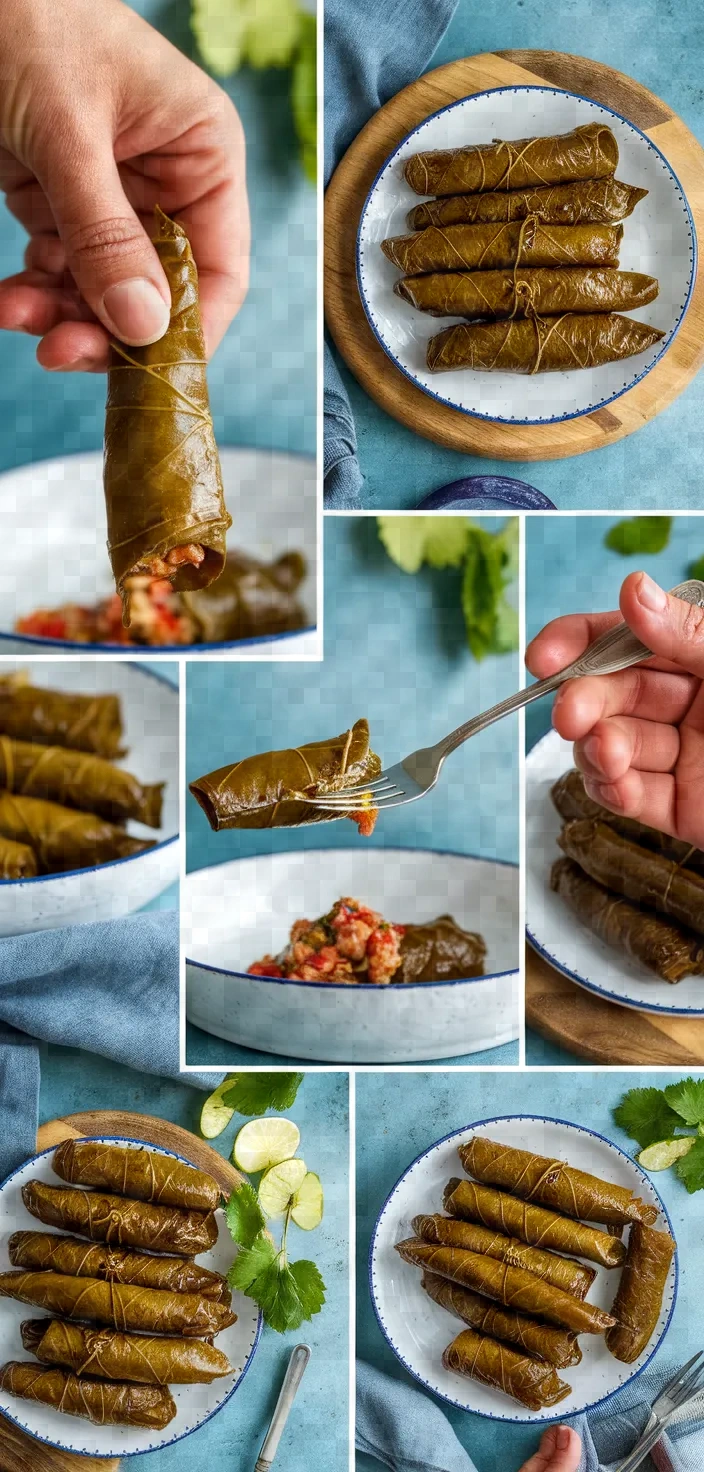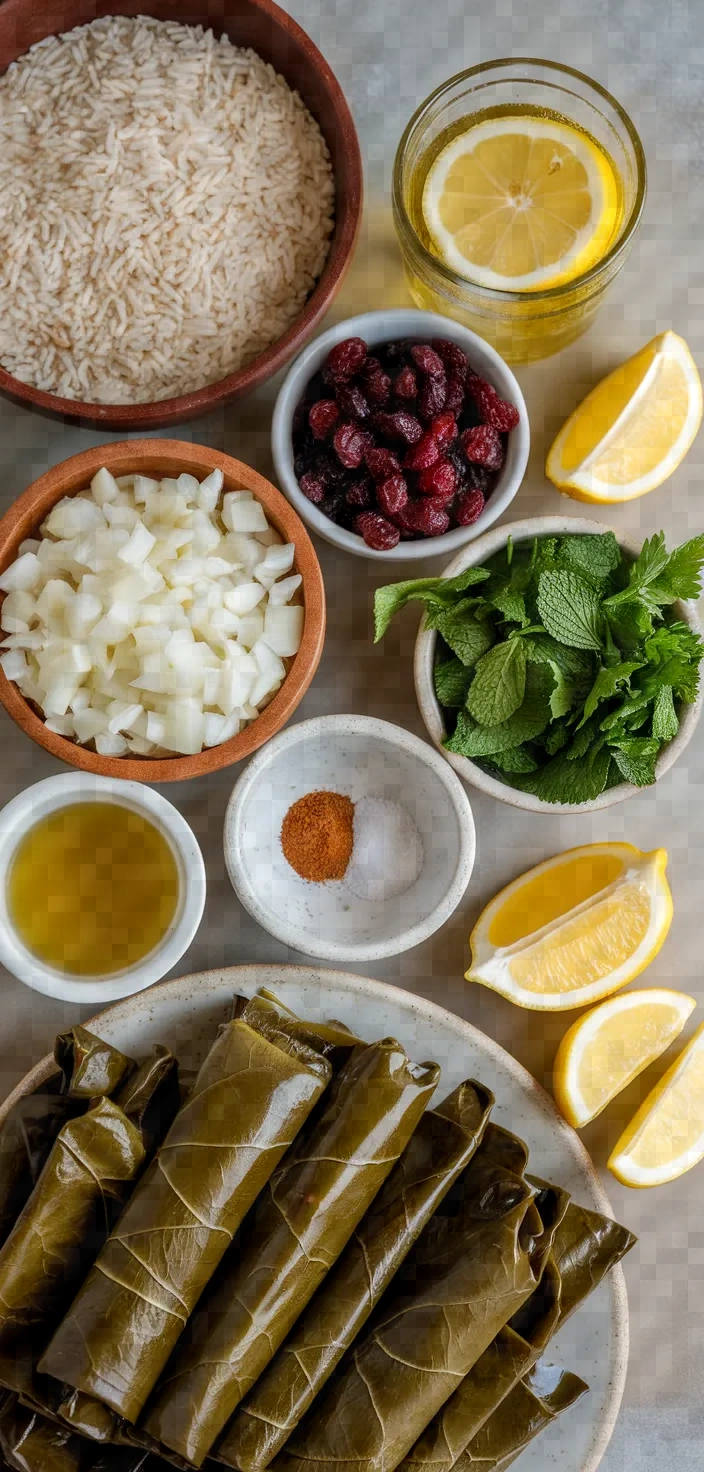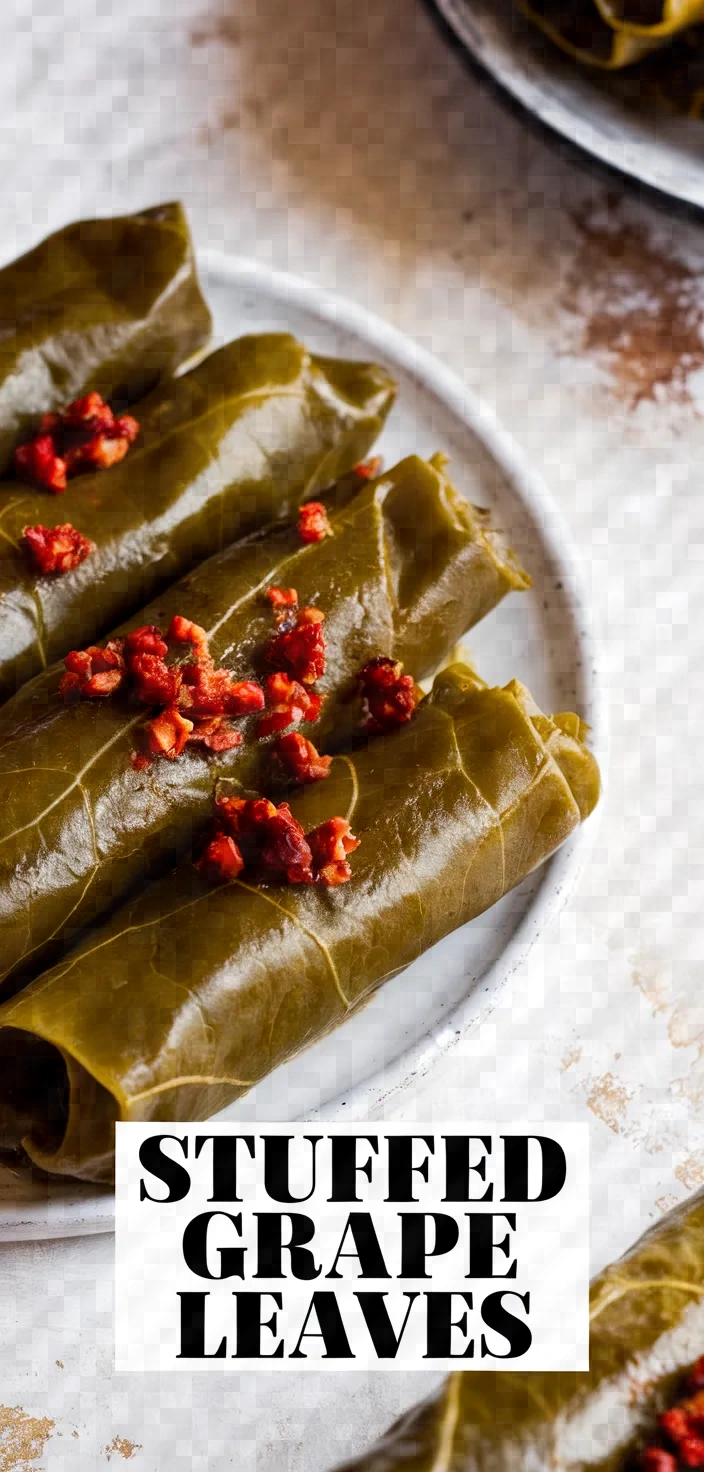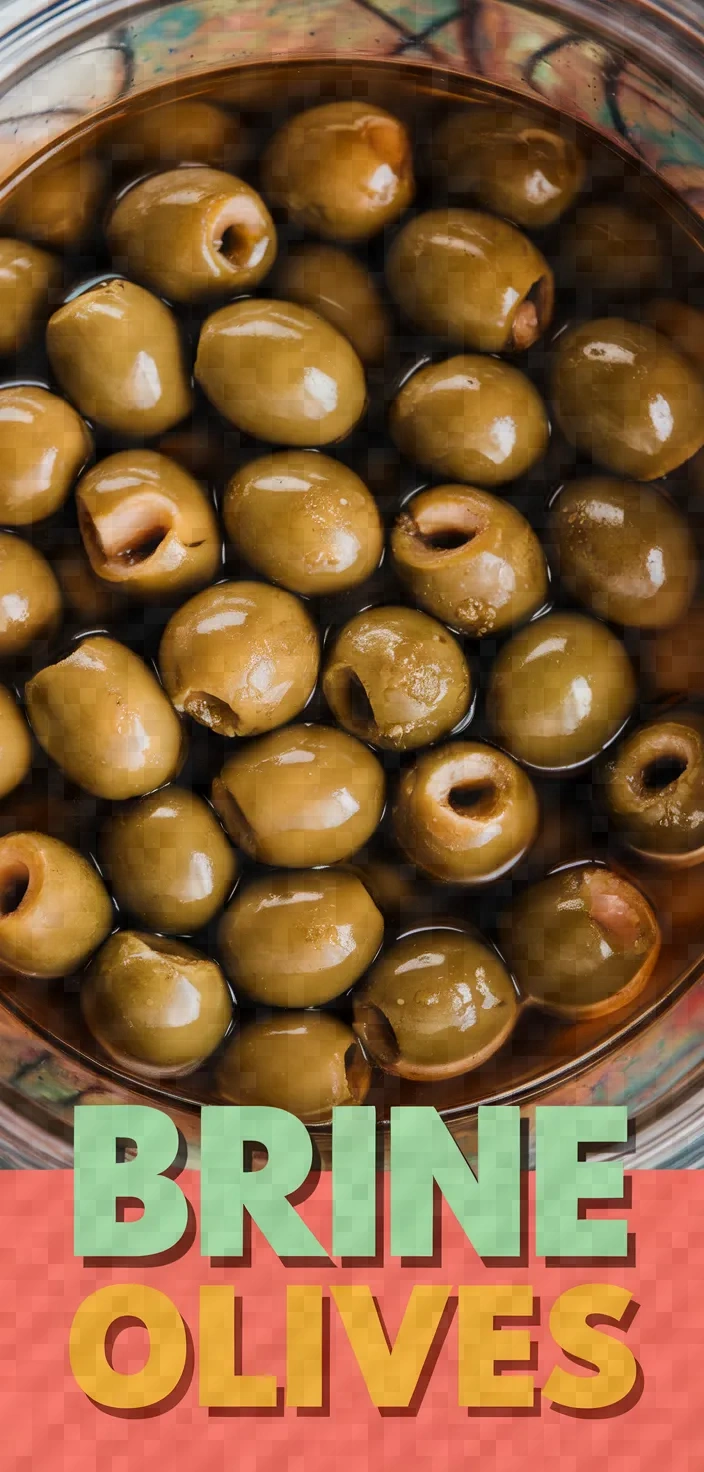Making these stuffed grape leaves reminds me of the warmth and aroma that fills the kitchen, a comforting ritual connecting past and present. There’s something truly special about rolling each leaf with the vibrant mix of rice, herbs, and spices, knowing they’ll soon transform into a delightful treat worthy of sharing.

Creating dishes filled with colors and flavors is my passion, and I love making these vibrant Meatless Stuffed Grape Leaves. They’re a delightful combination of long-grain rice, sweet currants, crunchy pine nuts, and aromatic mint.
Simmered in a nice vegetable broth, these savory Mediterranean parcels are a well-balanced mix of flavors and textures. Serve with lemon slices for a refreshingly zesty complement to this dish.
Meatless Stuffed Grape Leaves Recipe Ingredients

- Rice: Provides a hearty base, rich in carbohydrates.
- Pine Nuts: Add a buttery flavor and healthy fats.
- Currants/Raisins: Introduce a sweet contrast and iron.
- Parsley: Fresh herb adding vitamin C and flavor.
- Mint: Offers a refreshing taste and aids digestion.
- Allspice: Lends warmth and aromatic depth.
- Olive Oil: Rich in healthy monounsaturated fats.
- Grape Leaves: Low in calories, high in fiber and antioxidants.
Meatless Stuffed Grape Leaves Recipe Ingredient Quantities
- 1 cup uncooked long-grain white rice
- 1 onion, finely chopped
- 1/4 cup pine nuts
- 1/4 cup currants or raisins
- 1/4 cup chopped fresh parsley
- 1/4 cup chopped fresh mint
- 1 teaspoon ground allspice
- Salt and pepper, to taste
- 1/4 cup olive oil, divided
- 1 jar grape leaves in brine (about 60 leaves), rinsed and drained
- 3 cups vegetable broth
- 2 lemons, sliced
- Lemon wedges, for serving
How to Make this Meatless Stuffed Grape Leaves Recipe
1. Wash the rice in cold water until the water runs clear, to get rid of excess starch. Make sure to drain it nicely.
2. In a big pan, warm 2 tablespoons of olive oil over medium heat. Add the diced onion and cook until it is soft and see-through—approximately 5 minutes.
3. In a 4-quart saucepan, heat the 2 tablespoons olive oil over medium heat. Stir in the pine nuts and cook until golden, 2 to 3 minutes. Add the currants (or raisins), parsley, mint, allspice, salt, and pepper. Cook for another minute, stirring vigorously.
Looking for more impressive side dishes? Hover to see our top picks!
4. Introduce the rice to the amalgam of onions and spices. Cook for another 2-3 minutes, giving the rice a good stir every so often, to make sure it is well coated with the delicious flavors you’re creating. Remove from the heat and let it cool and continue its transformation for a bit.
5. Place the rinsed grape leaves on a flat surface, with the shiny side facing down. Near the stem end of each leaf, put 1 to 2 teaspoons of the rice mixture.
6. Fold the leaf sides over the filling, then roll it neatly into a cylinder, starting from the end with the stem. Perform the same steps with the other leaves and filling.
7. In a big pot, put down some grape leaves that have not been used on the bottom to keep from sticking. Put in the pot the grape leaves that have been stuffed and place them seam side down in the pot. Make sure they are packed in tightly and level as you go across the top.
8. Drizzle in the rest of the olive oil and the vegetable broth over the stuffed grape leaves. Lay in slices of lemon to impart some good flavor.
9. Put a plate that can withstand heat on top of the grape leaves to keep them steady, then heat the pot until it is just simmering (you want a gentle heat here; too much heat will crack your pot). Cover the pot and cook for about 45 minutes, or until you can open it and see that the rice is tender.
10. Allow the stuffed grape leaves to reach room temperature before serving. Provide lemon wedges alongside for a delightful flavor boost. Enjoy!
Meatless Stuffed Grape Leaves Recipe Equipment Needed
1. Measuring cups
2. Colander or fine mesh sieve
3. Large pan
4. 4-quart saucepan
5. Wooden spoon or spatula
6. Cutting board
7. Sharp knife
8. Large pot with lid
9. Ladle or serving spoon
10. Large plate for pressing
11. Serving platter or dish
FAQ
- Q: Can I use brown rice instead of white rice?A: You can certainly use brown rice as a substitute, but it requires longer cooking time. Adjust the cooking time and add extra vegetable broth if using brown rice.
- Q: Can I make these grape leaves ahead of time?A: For sure! They can be prepared a day in advance. Refrigerate them and serve them at room temperature or reheat them. They’re not too picky.
- Q: How do I prevent the grape leaves from unrolling?A: To maintain their tight roll, make sure the leaves’ sides are tucked in nicely and that they are placed in the pot with the seams facing down.
- Q: What can I use as an alternative to pine nuts?If you’re allergic to or just really, really dislike pine nuts, or if you prefer a different texture, feel free to use chopped walnuts or almonds instead. They’re great substitutes. I would not, however, recommend halved peanuts or pecans. Peanuts don’t bring anything to the party that walnuts or almonds can’t do better, and pecans are too soft to give you that satisfying crunch in your pesto.
- Q: Can I freeze stuffed grape leaves?A: Yes, you can freeze them. After cooking and cooling them, put them in an airtight container, and they can last in the freezer for around 2 months. You should thaw them in the fridge before you serve them.
- Q: How do I serve the stuffed grape leaves?A: Offer them cold or at ambient temperature with lemon wedges alongside for a crisp citrus accent.
Meatless Stuffed Grape Leaves Recipe Substitutions and Variations
You can replace the long-grain white rice with brown rice, which will give a nuttier flavor and some extra fiber, since brown rice is a whole grain.
You could substitute with chopped walnuts or almonds if pine nuts are not available. They provide a similar texture.
For currants or raisins, chopped dried apricots or dried cranberries can be an appropriate substitute.
If locating fresh mint proves difficult, you can use dried mint in its place; however, you should use a quantity approximately half of what you would use of the fresh variation.
If a jar of grape leaves isn’t your thing, use Swiss chard instead. These leaves will give you a softer texture, which some of us prefer.
Pro Tips
1. Soak the Grape Leaves: Before using grape leaves from a jar, soak them in water for about 30 minutes, then rinse thoroughly. This helps to remove excess salt from the brine and makes the leaves more pliable for wrapping.
2. Toasting the Pine Nuts: Keep a close eye on the pine nuts while toasting, as they can burn quickly. Stir constantly and remove them from the heat just as they turn golden to avoid a bitter taste.
3. Resting the Filling: After mixing the rice with the spices and herbs, let the filling cool and rest for about 10-15 minutes before filling the grape leaves. This allows the rice to absorb more flavor and makes it easier to handle.
4. Rolling Technique: When rolling the grape leaves, try not to overfill them. Leave a bit of room for the rice to expand during cooking to prevent the leaves from tearing.
5. Cooking with Care: Place a heatproof dish or inverted plate on top of the rolled grape leaves in the pot. This helps to keep them compressed and prevents them from unwrapping during cooking. Also, ensure the cooking liquid is simmering gently to avoid disrupting the rolls.

Meatless Stuffed Grape Leaves Recipe
My favorite Meatless Stuffed Grape Leaves Recipe
Equipment Needed:
1. Measuring cups
2. Colander or fine mesh sieve
3. Large pan
4. 4-quart saucepan
5. Wooden spoon or spatula
6. Cutting board
7. Sharp knife
8. Large pot with lid
9. Ladle or serving spoon
10. Large plate for pressing
11. Serving platter or dish
Ingredients:
- 1 cup uncooked long-grain white rice
- 1 onion, finely chopped
- 1/4 cup pine nuts
- 1/4 cup currants or raisins
- 1/4 cup chopped fresh parsley
- 1/4 cup chopped fresh mint
- 1 teaspoon ground allspice
- Salt and pepper, to taste
- 1/4 cup olive oil, divided
- 1 jar grape leaves in brine (about 60 leaves), rinsed and drained
- 3 cups vegetable broth
- 2 lemons, sliced
- Lemon wedges, for serving
Instructions:
1. Wash the rice in cold water until the water runs clear, to get rid of excess starch. Make sure to drain it nicely.
2. In a big pan, warm 2 tablespoons of olive oil over medium heat. Add the diced onion and cook until it is soft and see-through—approximately 5 minutes.
3. In a 4-quart saucepan, heat the 2 tablespoons olive oil over medium heat. Stir in the pine nuts and cook until golden, 2 to 3 minutes. Add the currants (or raisins), parsley, mint, allspice, salt, and pepper. Cook for another minute, stirring vigorously.
Looking for more impressive side dishes? Hover to see our top picks!
4. Introduce the rice to the amalgam of onions and spices. Cook for another 2-3 minutes, giving the rice a good stir every so often, to make sure it is well coated with the delicious flavors you’re creating. Remove from the heat and let it cool and continue its transformation for a bit.
5. Place the rinsed grape leaves on a flat surface, with the shiny side facing down. Near the stem end of each leaf, put 1 to 2 teaspoons of the rice mixture.
6. Fold the leaf sides over the filling, then roll it neatly into a cylinder, starting from the end with the stem. Perform the same steps with the other leaves and filling.
7. In a big pot, put down some grape leaves that have not been used on the bottom to keep from sticking. Put in the pot the grape leaves that have been stuffed and place them seam side down in the pot. Make sure they are packed in tightly and level as you go across the top.
8. Drizzle in the rest of the olive oil and the vegetable broth over the stuffed grape leaves. Lay in slices of lemon to impart some good flavor.
9. Put a plate that can withstand heat on top of the grape leaves to keep them steady, then heat the pot until it is just simmering (you want a gentle heat here; too much heat will crack your pot). Cover the pot and cook for about 45 minutes, or until you can open it and see that the rice is tender.
10. Allow the stuffed grape leaves to reach room temperature before serving. Provide lemon wedges alongside for a delightful flavor boost. Enjoy!















